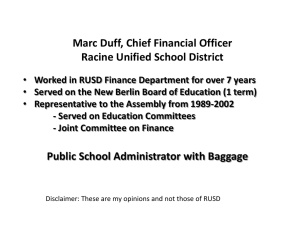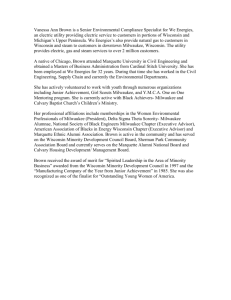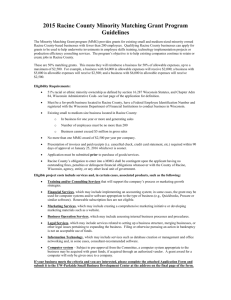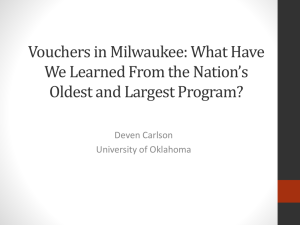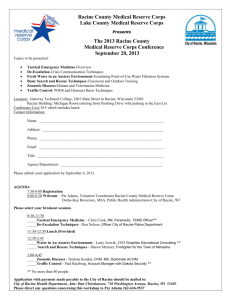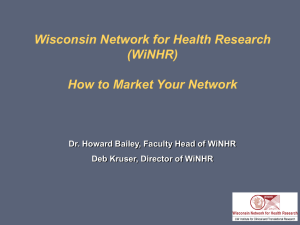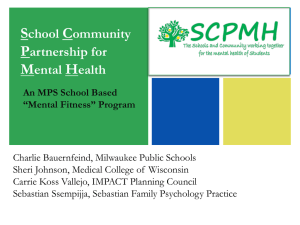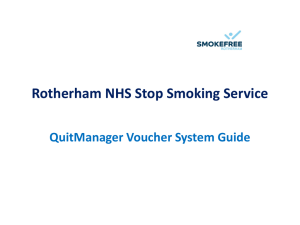School Choice Wisconsin
advertisement
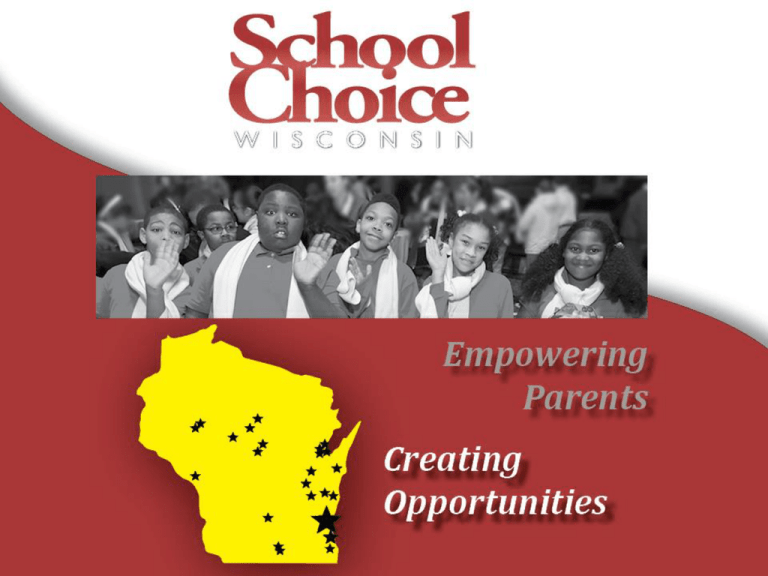
A state organization staffed to advance legislative as well as regulatory agenda Advocates exclusively for private and religious school choice Frequently consult with schools and sponsoring bodies to identify the legislative agenda and fight off bureaucratic assaults Act as the ‘help desk’ for schools, complete pinpointed research to drive legislative agenda About us Six staff members Privately funded Also staff the Alliance for Choices in Education and the Fund for Parent Choice School Choice Wisconsin To give parents more control over their child's education, and to allow parents to pursue the most appropriate learning environments for their children. Religious instruction Stronger discipline and school culture Better foundational skills including reading, writing, mathematics, and science Specific skills Goal of School Choice Competition amongst schools for students Schools that fail to attract students close Superior schools grow and replicate Catalyst for schools to create innovative programs More responsive to parental demands Cost effectiveness for taxpayers Benefits of School Choice Programs in Milwaukee and Racine 26,000 students in Milwaukee, 1200 in Racine 125 private and religious schools $7210/7856 maximum reimbursement Statewide Wisconsin Parental Choice Program 31 schools and 1000 students outside Milwaukee and Racine Choice in Wisconsin Parents receive a voucher from the state to enroll their children in participating private and religious schools. The program is limited to those families with adjusted gross incomes at or below 185% of federal poverty. In 2014-15, participation was limited to 1000 students with no more than 1% from any individual school district. SCW is working to include in the 2015-2017 state budget significant expansion in number vouchers, no limit on the number of participating schools, and no limit on percentage of public school district enrollment. The Wisconsin Parental Choice Program Summary Vouchers empower parents to choose a private or religious school for their children in lieu of assignment to the a specific public school. Typically, the voucher represents a portion of state and local funding that would have been expended by the public school district on the student. Savings to the state and local taxpayers. The voucher is allocated to a participating family and used as full or partial payment of tuition at the private or religious school. What is a voucher? Is it a good fit for your school? Cost vs. Benefit DPI Auditor fee Semi-annual audits Extra admissions work Student Information System (SIS) Voucher=$7,210 K-8 or $7,856 HS Serve more students Vouchers and Schools Is it a good fit for your school? Autonomy Curriculum decisions – YOU decide Enrollment numbers – YOU decide Vouchers and Schools Eligible students includes all pupils, whether public school students or private school students, in grades 4K-12. The school determines the grade levels and the number of seats it will make available. Which students and which grades? Online application Provide proof they meet residency and income requirements The online application is not complete until the school to which they have applied has verified and accepted the required documentation. How do parents apply? Parents must reply to the school. If the parent has applied to more than one school, the parent must choose which school they wish to attend and reply to that school within five days of notification. Thank God and jump for joy! What do parents do if their child is accepted? Qualifying Incomes for Milwaukee and Racine Programs Family Size 3 4 5 6 Single Income Married Income (+$7000) $59,409 $71,637 $83,865 $96,093 $66,409 $78,637 $90,865 $103,093 Income levels are Adjusted Gross Income (AGI) 300% of Federal Poverty 2014-2015 Qualifying Incomes for Statewide WPCP Family Size 3 4 5 6 Single Income Married Income (+$7000) $36,636 $44,177 $51,718 $59,259 $43,636 $51,177 $58,718 $66,259 Income levels are Adjusted Gross Income (AGI) 185% of Federal Poverty 2014-2015 A “once in, always in” provision allows family income to rise once a student is in the statewide school choice expansion. Family income is determined for each student in the year they enter the program. Families could have some children qualify and others that do not depending on family income in the year each child enters the program. Please note this only applies if a student continues to attend a school in the school choice program and does not voluntarily leave the program. What if family income rises in subsequent years? Parents may not be charged additional tuition for grades K-8. A school may charge a student reasonable fees for personal items such as towels, gym clothes or uniforms, social and extracurricular activities if the activity is not a part of the required curriculum, musical instruments, meals, and high school classes not required or credited for graduation. A student may not be charged a fee for registration or application to the program, books, teacher salaries, buildings, maintenance, equipment, computers, and any other fee directly related to the required curriculum. Will parents have to pay additional tuition and fees? Yes Will the child be required to follow the school rules? No. If the school chooses to provide transportation, a fee may be charged. In some cases, the school district of residence will provide transportation or reimburse the parent a certain amount for their transportation costs through a contract. Must a school provide transportation? PCP schools with available seats must accept any student that meets income eligibility and residency requirements – cannot select students based on other factors However – as a private school, a school in the PCP is only required to offer services to a special needs student that it can provide with minor adjustments According to the SCDP between 7.5 and 14.6 percent of students in private schools in the MPCP have a disability Special Needs Increased per pupil funding $7210 K-8 $7856 High School Creation of the Wisconsin Parental Choice Program The program is limited to those families with incomes below 185% of the federal poverty level. In 2014-15, participation is limited to 1000 students with no more than 1% from any individual school district. Changes in the 2013 Budget January – attend DPI training in Madison February 1st May 1st Submit Intent to Participate Form Pay nonrefundable DPI auditor fee Submit hour of instruction report Start accepting student applications Submit budget to DPI August 1st Certificate of occupancy Proof of insurance/fidelity bond Pre-accreditation Timeline to join program Since 1990, six studies have examined the fiscal impact of school choice on taxpayers All six show school choice saves money for taxpayers None found a negative impact $230 million saved in Wisconsin 1990-2011 just in the Milwaukee program Over $300 million saved in Milwaukee, Racine, and statewide through 2014 School Choice Saves Money Private schools are accountable to parents who can pull their child out of a school that fails them. Private school comply with a vast array of health and safety issues, anti-discrimination and civil rights laws, accreditation requirements, financial audits, and disclosure of student performance on standardized tests. The school choice programs in Wisconsin are the most regulated and accountible in the nation. School Choice is Accountable Schools in the MPCP are supportive of targeted accountability measures ensuring the MPCP remains a high quality program including: Fiscal accountability Testing Accreditation and pre-accreditation Bad actor provisions Over 40 low-performing schools removed as a result of targeted accountability measures Accountability Overwhelmingly, academic studies have found that school choice improves public schools Increased responsiveness to competition No creaming of the best students Of 23 studies, none have shown that school choice harms public schools School Choice Does Not Hurt Public Schools? When students leave the public school through school choice, the public school is relieved of the duty/cost of educating those students. Typically, private schools are less expensive to taxpayers than public schools. As students tranfer to private schools, government can choose to increase per pupil spending at the public schools. School Choice Does Not Drain Resourses from Public Schools Twelve gold-standard random-assignment analyses of school choice All twelve studies showed better academic outcomes for the school choice students than for the contol group Eleven of twelve studies achieved a high level of statistical certainty No study found that school choice had a negative impact on student achievement School Choice Has a Positive Effect on Academic Achievement MPCP Longitudinal Growth Study showed that MPCP students exhibited greater growth in reading achievement compared to similar group of MPS students According to the School Choice Demonstration Project (SCDP), students who attended MPCP schools for four years had significantly higher graduation rates (94%) than students who attended MPS high schools for four years (75%) Students in MPCP have higher graduation rates than similar students in MPS and are more likely to enroll and remain in a four-year college compared to similar MPS students, according to SCDP Results in Milwaukee Remember to apply for the WPCP by Feb 1, 2015 Please email or call Terry Brown at School Choice WI for assistance including an onsite presentation or meeting 414-319-9160 brown@parentchoice.org Thank You!
